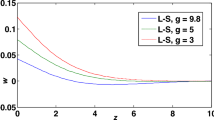Abstract
A new explicit analytical formula for calculating the temperature variation of elementary solids and fluids along the isentrope is proposed. The optimality of the formula is demonstrated by calculating unloading isentropes of liquid and solid diamond under shock compression and those of solid molybdenum and gold.
Similar content being viewed by others
REFERENCES
J. M. Walsh and R. H. Christian, "Equation of state of metals from shock wave measurements," Phys. Rev., 97, No. 6, 1544-1556 (1955).
Ya. B. Zel'dovich and Yu. P. Raizer, Physics of Shock Waves and High-Temperature Hydrodynamic Phenomena, Academic Press, New York (1967).
J. R. Asay and M. Shahinpoor (eds.), High-Pressure Shock Compression of Solids, Springer-Verlag, New York (1993).
R. G. McQeen, S. P. Marsh, J. W. Taylor, et al., "Equation of state of solids from shock wave measurements," in: R. Kinslow (ed.), High-Velocity Impact Phenomena, Academic Press, New York-London (1970).
L. V. Al'tshuler, A. V. Bushman, M. V. Zhernokletov, et al., "Unloading isentropes and equations of state of metals at high energy densities," Zh. Éksp. Teor. Fiz., 78, No. 2, 741-760 (1980).
V. N. Zharkov and V. P. Trubitsyn, Physics of Planet Depths [in Russian], Nauka, Moscow (1980).
A. M. Molodets, "Free energy of diamond," Fiz. Goreniya Vzryva, 34, No. 4, 94-101 (1998).
A. M. Molodets, M. A. Molodets, and S. S. Nabatov, "Free energy of liquid diamond," Fiz. Goreniya Vzryva, 35, No. 2, 81-87 (1999).
A. M. Molodets, "Free energy and thermodynamics of shock compression of solids," Khim. Fiz., 16, No. 9, 132-141 (1997).
A. M. Molodets, M. A. Molodets, and S. S. Nabatov, "Free energy of melt metals," Teplofiz. Vys. Temp., 36, No. 6, 914-920 (1998).
A. M. Molodets and S. S. Nabatov, "Thermodynamic potentials, diagrams of state, and phase transition of tin under shock compression," Teplofiz. Vys. Temp., 38, No. 5, 741-747 (2000).
D. V. Sivukhin, Handbook on Physics [in Russian], Vol. 2, Nauka, Moscow (1975).
R. G. McQeen and S. P. Marsh, "Equation of state of 19 metals from shock wave measurements up to 2 Mbars," J. Appl. Phys., 31, No. 7, 1253 (1960).
K. A. Gschneider, "Physical properties and interrelationships of metallic and semimetallic elements," Solid State Phys., 16, 275-446 (1964).
I. V. Lomonosov, "Phase diagrams and thermodynamic properties of metals at high pressures and temperatures," Doct. Dissertation in Phys.-Math. Sci., Moscow (1999).
M. F. Gogulya and M. A. Brazhnikov, "Temperatures of detonation products of condensed explosives. Part 1. Solid explosives," Khim. Fiz., 10, No. 1, 52-63 (1994).
A. E. Sheindl in (ed.), Thermophysical Properties of Molybdenum and Its Alloys: Handbook, [in Russian], Metallurgiya, Moscow (1990).
M. A. Al'tshuler, S. E. Brusnikin, and E. A. Kuz'menkov, "Isotherms and Grüuneisen functions of 25 metals," Prikl. Mekh. Tekh. Fiz., No. 1, 134-146 (1987).
Author information
Authors and Affiliations
Rights and permissions
About this article
Cite this article
Molodets, A.M. Use of the Grüneisen Coefficient in Calculations of Temperature along the Isentrope of Elementary Substances. Combustion, Explosion, and Shock Waves 37, 455–460 (2001). https://doi.org/10.1023/A:1017909214815
Issue Date:
DOI: https://doi.org/10.1023/A:1017909214815



